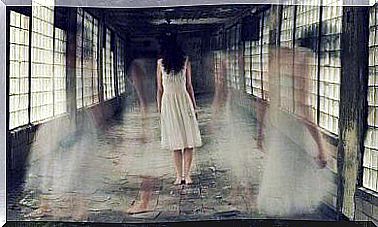Sleepwalking According To Neuroscience

Generally, sleepwalking is a well-known sleep disturbance. It is characterized by an unconscious “awakening” which causes people to wander in their house. During an episode of sleepwalking, people may just walk aimlessly, even engaging in more complex activities like cooking. Sometimes it goes as far as driving a car.
This disorder is characterized by two fundamental aspects:
- Complex motor behaviors
- Altered state of consciousness
During an episode of sleepwalking, the sufferer exhibits unconsciously uncontrolled behavior. It does not have the capacity to react to external stimuli and has a strong autonomous activity (sweating, tachycardia…). Plus, if she wakes up during the episode, she does so in a confusing way. Finally, she spontaneously returns to bed and continues to sleep normally.

The sleep
To understand this disorder, you need to understand how sleep works. Depending on muscle tone, brain activity and motor activity of the eyes, sleep can be divided into two main types:
- Non-REM sleep (no rapid eye movements). Non-REM sleep, in turn, is divided into N1 (onset of sleep), N2 (light sleep), and N3 (deep or slow sleep).
- REM sleep (rapid eye movements or REM).
Thus, during the night we move from one stage to another, all being essential for a good rest. If you want to know more about them, you can check the following article:
Non-REM sleep parasomnia
Sleepwalking, which occurs in N3, is classified as a non-REM sleep parasomnia, with night terrors and confused awakenings. In fact, it has been argued that these three events are in fact the same arousal disorder (level of brain activation), but with different manifestations.
Sleepwalking episodes are preceded by a phase of strong slow wave activity. Slow waves, or delta, represent synchronized, rhythmic and, as the name suggests, slow activity in the frontal and central areas of the brain. With a phase of high voltage and another of inactivity for a few milliseconds.
What happens in the brain during sleepwalking?
Sleepwalking, although known for its manifestations and having been researched for more than five decades, remains a mystery as to its causes. Nevertheless, due to its two great characteristics, several serious assumptions have been made about it.
On the one hand, it is a slow wave sleep disorder. In the sleepwalker’s brain, there does not appear to be a continuity of REM sleep, but sudden changes in its frequency and amplitude, whereas in individuals without sleepwalking, yes. When the disorder exists, there is an increase in spontaneous awakenings exclusively in slow sleep and an increase in activity in the rest of the phases.
On the other hand, sleepwalking is considered a disorder of arousal or brain activation. From this perspective, sleepwalking falls between a state of full activation and a state of non-REM sleep. That is, he is not fully awake, nor fully asleep. This implies the existence of a slight activation of the prefrontal areas, when they should be inactive. However, it is not yet clear why these alterations occur.

Other data on sleepwalking
In addition, sleepwalking is linked to other factors: fragmentation or deprivation of sleep, fever, substance use, stress and, surprisingly, pregnancy. There are also other pathologies that can be at the origin of this disorder, such as obsession, schizoid, anxiety, depression, encephalopathy, cognitive disorders or migraine.
Its relationship to this symptomatology has led us to believe that mechanisms such as systems that regulate dopamine, acetylcholine or serotonin could be involved. In this sense, although there is no effective treatment for sleepwalking, stress reduction treatments and generally benzodiazepines, such as clonazepam and others, are prescribed.










